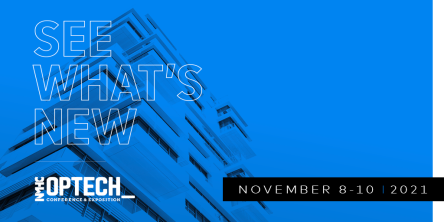The NMHC OPTECH Conference & Expo returns as an in-person gathering Nov. 8-10 in National Harbor, Maryland. 2021 NMHC OPTECH, presented by the National Multifamily Housing Council, provides multifamily property owners and operators with tools and insight that will help them compete and prepare for emerging challenges in the pandemic’s aftermath. Yardi is a top-tier Chair’s Circle Sponsor of the conference. Booth 401 is “where success happens” for attendees, featuring demos of: REACH by RentCafe®, which improves marketing ROI with advanced digital marketing services including SEO, PPC, social media, reputation management and performance analytics.RentCafe® Home IQ, which increases revenue and efficiency with smart home automation.ScreeningWorks® Pro, which mitigates fraud risk by seamlessly incorporating credit reports, rental history, income and other publicly reportable civil or criminal data in the leasing process.The Yardi® Multifamily Suite, which drives better results with a single connected solution for property management.Yardi® Breeze Premier, an easy-to-use, all-in-one marketing, management and accounting platform. Yardi also plays a central role in several presentations, starting with the opening general session, “Here Comes the Sun! Industry Leaders Look Forward to a Brighter Future.” Richard Malpica, Yardi vice president and Eastern region general manager, will moderate a discussion with industry leaders from KETTLER, CAPREIT and RKW Residential about opportunities in 2022. Also on Tuesday, Nov. 9, Chris Lindish, director of the REACH by RentCafe digital marketing agency, will present an express session on “Marketing Data Exposed: Uncovering Metrics that Drive Results.” The day will close with a panel moderated by Michael Tuer, Yardi vice president and Central region general manager. Panelists from BH Equities LLC, Mg Properties and Draper & Kramer will discuss “How to Make Better Technology Decisions” and share their approach to evaluating new technologies and striking a balance between organizational goals and role-based...
Clean is the New Green
Creating healthier buildings
Back in 1946, we were on to something. The American Standards Association, now the American National Standards Institute, issued guidelines for healthy buildings. Among the standards stood a novel concept: occupied rooms should have access to fresh air. It seems like common sense now, but it’s not common practice today. That standard was all but forgotten by 1981 and the repercussions haunt us through the pandemic. Fortunately, a new class of experts highlights the benefits of healthy buildings as a way to promote public health and improve asset value. Introducing Joseph Allen, breathing new life (and science) into old ideas Joseph G. Allen is an assistant professor at the Harvard T.H. Chan School of Public Health. He is also the faculty advisor to the Harvard Healthier Building Materials Academy. During NMHC OPTECH 2020, Allen lead the session “Clean is the New Green.” He guided participants through the numerous ways in which buildings can prevent the spread of germs, promote health and yield higher returns for investors in the process. His session brought participants back to December 2019. Allen and his peers wrote an article on the importance of healthy buildings research to advance health. SARS and other epidemics inspired the paper, but they had no idea how close they were to the brink of a pandemic. “We had narrow misses in the past, influenza epidemics that were nearly pandemics. We knew that we were overdue, and we knew that buildings would play a role,” says Allen. Less than a month later, COVID-19 hit the U.S. By the end of the season, the pandemic had the globe in its grips. Allen and his team worked tirelessly to educate the public on the role that enclosed spaces play in the transmission and prevention of disease. “We have to understand first how we are exposed, and then we can simply line up the corresponding control strategies, like higher ventilation, better filtration and use of masks,” says Allen. Controlling exposure points begins with the air The potential for close contact transmission, contaminated surfaces and airborne transmission must all be addressed in healthy buildings. Airborne transmission is the trickiest to manage. Smaller airborne particles can linger in the air for 30 minutes. They can travel beyond six feet with studies showing “viable virus as far as 16 feet,” reports Allen. Creating a healthy interior space requires more than social distancing. “In each outbreak, people were indoors with no masks and low to no ventilation. This is so important because airborne transmission is what drives super spreader events,” explains Allen. “A study published just last year found that ensuring even minimum levels of outdoor air ventilation reduced influenza transmission as much as having 50 % to 60 % of the people in a building vaccinated,” says Allen. Buildings can help to reduce the spread of disease through intentional ventilation and filtration techniques. Builders and managers acknowledged this fundamental truth in the late 1940s. By the early 1980s, however, efforts to reduce energy consumption lead to poorer indoor air quality. “We’ve lost our way over time,” explains Allen. “We’ve placed the emphasis only on energy. As a result, we are here in the sick building era where buildings can’t respond to the crisis at hand. They can’t bring in outdoor air.” Allen advises building managers to bring in as much outdoor air as they can to dilute airborne viral particles. It’s often as simple as opening the dampers. Recirculated air should be filtered by a MERV13 or higher filter. Such filters capture at least 80% of viral particles. If managers cannot reach those standards, Allen recommends the use of portable air cleaners with HEPA filters, which capture 99.97 percent of particles. Building building resiliency Americans spend 90% of our time indoors. Curiously, funding in the health industry often goes towards research regarding exercise, nutrition and the impact of external pollutants such as cigarettes and smog. Allen explores the...
5 Tech Takeaways
From NMHC OPTECH
NMHC OPTECH 2019 in Dallas was the place to be for multifamily real estate execs seeking strategies to raise their game using technology — especially looking ahead to a likely downturn. In lively peer roundtable discussions and dynamic property and revenue management workshops and sessions, industry insiders dove into the big issues facing multifamily businesses. Compelling strategies emerged for growing revenue, managing all lease types and improving the customer experience using new technology. Read on for our top five takeaways from this year’s event. Unleash data Gone are the days of making business decisions based on guesswork and backward-looking data aggregated into spreadsheets. Today, new technology automates data collection with advanced analytics to provide a complete picture of a portfolio’s opportunities and future risks. That’s big data, and it’s a big deal. At OPTECH, experts talked about the valuable business intelligence hiding in your company’s data, and how to capture it to improve all operational systems and processes from front office to back office, including revenue management and rental pricing. In the session “Apples to Apples: Getting Clean Consistent Data for Accurate BI” data experts and asset managers discussed evolving corporate best practices in performance data tracking. Starting with clean, reliable data from a single database for one source of truth is essential. Using a system that leverages that data with machine learning and artificial intelligence to deliver predictive analytics with recommended actions is keeping leading companies ahead of the curve. And don’t forget about futurecasting. You can get a clear picture of potential future income using reliable operational data. Smart forecasting tools drill down to lease level data and also factor in market conditions and industry dynamics, so you can stay agile and plan for what happens next. Protect information The...



